Contents
Introduction
Head of a Man came to Tate in 1919. In the years it has been on the gallery walls, it has provoked debate and curiosity by those that see it. Its current title (and the title has changed numerous times over the years) suggests this is simply a painting of man. Yet, the fact that John Simpson’s painting is of a Black man cannot be ignored, especially when you look at other figures in artworks from the era - the majority startling white. Questions still arise over the identity of this man and why Simpson decided to paint him.
What's my name?
When the painting was first exhibited in 1827 at the British Institution, it had the title Head of a Black. When the painting was engraved in the Art Journal in 1853, it was simply titled The Negro. It was acquired by the National Gallery in 1847, but remained mostly in storage. Years later, it was taken to Tate in 1919, but has only been on permanent display since 2013. In 1919, it was given the name Head of a Negro. Today, it is known as Head of a Man (?Ira Frederick Aldridge).
Its current title does not refer to the race of its subject. Possibly, this comes from fear and anxiety not to emphasise or differentiate the painting by its subject’s skin colour. Yet, it is impossible to ignore the racial politics of this piece. This is a painting of a Black man, painted at a time when slavery was still in the process of being abolished in the Empire. His skin colour is vital to the painting’s purpose and meaning.

Even more interesting is that this man is not named. The subject is meant to be anonymous. Every title given to this painting depersonalises the subject. Although its current title does make note that this is possibly Ira Aldridge, an actor famous at the time, we cannot be sure. No title can confirm who Simpson was painting.
Titling this piece then is a contentious issue. Perhaps, Head of a Man is appropriate, because it qualifies the sitter as a man, rather than as a Black man, reducing the risk of the subject being seen as a figurehead for his race. This though causes a conflict as it potentially robs the sitter of his identity. What is more important to understanding the significance of this painting - the subject's race or his identity? Head of a Man does neither, but should it and if so, how? Does (? Ira Frederick Aldridge) in the title do enough to hint to the possible identity of the sitter? Does the title Head of a Man do enough to recognise the sitter's race?
The man behind the painting

As the title in brackets suggests, it is probable that Simpson was painting Ira Aldridge, the famous Shakespearean actor of the day. In 1824, Aldridge emigrated to Liverpool from America having struggled to become an actor because of the country’s discrimination against Black actors.
In Britain, the slave trade had been outlawed in 1807, but would not be abolished in the Empire until 1833. The Industrial Revolution had brought about an increase in theatres in the country. Aldridge took an opportunity. He knew how to garner attention and acted like a celebrity, making people take notice of him.
A year after arriving in Britain, Aldridge made his debut on the London stage. He was cast mostly as enslaved characters in plays like The Slave’s Revenge and The Slave. He was cast in the titular role of Othello. Critics were often racist, with The Times commenting on his ‘lips so shaped that it is utterly impossible for him to pronounce English’.
When Aldridge was rarely cast in roles typically for white Europeans, it was in the negative role. He played the title role in Shakespeare’s Richard III and as Shylock in The Merchant of Venice. In both plays, he was given prominent parts but seen as an appropriate villain most probably for his ethnicity and an audience’s ability to quickly associate him with the other. It was not until later in life that Aldridge, now an international name, was cast in the title role of King Lear.
Aldridge was a man who was vocal about the cruelty of slavery. He would directly address audiences on the closing night of every performance, a tradition where he would speak about his political beliefs. His interracial marriage to Margaret Gill, a white woman from Yorkshire, in 1825 caused much controversy and made Aldridge a man well-known in the press.
The Black Everyman
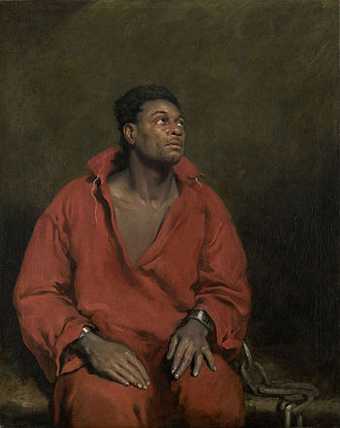
John Simpson The Captive Slave 1827
Art Institute of Chicago
The question then remains that if this was Aldridge, why did Simpson choose not to name his sitter? Other artists such as Henry Perronet Briggs, James Northcote and John Jackson painted Aldridge because he was famous and a recognised name. Aldridge also liked being painted as it increased his status and fame. In saying this, it was not custom for portraits of Black people to name their subjects. Black subjects were dressed as characters. In most cases, Aldridge was painted as Othello, rather than as himself. As he is not named in Simpson's painting, it is possible to question what character Simpson was painting him as.
Simpson painted Aldridge again in the same year in the far grander The Captive Slave. The painting showcases Aldridge as an enslaved person, shackled and in the garbs of a prisoner. This was a rare depiction of slavery for portraiture at the time. Simpson, an advocate for the abolition of slavery, used the painting as a way to humanise the Black man to his audience. Perhaps, Aldridge is not named, because he was not a enslaved person and hence this would distort the intentions Simpson had for his painting.
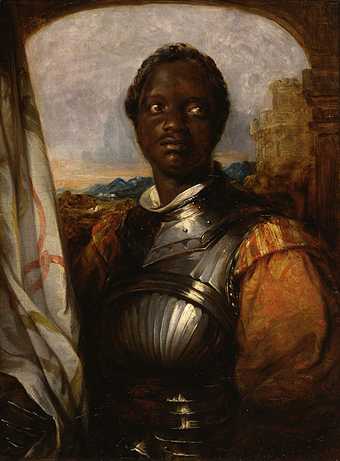
William Mulready Ira Aldridge, Possibly in the Role of Othello 1826
The Walters Art Museum
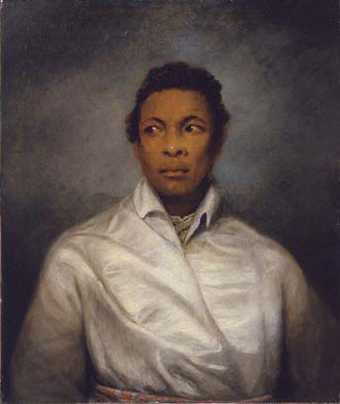
James Northcote Ira Fredrick Aldridge 1826
National Portrait Gallery
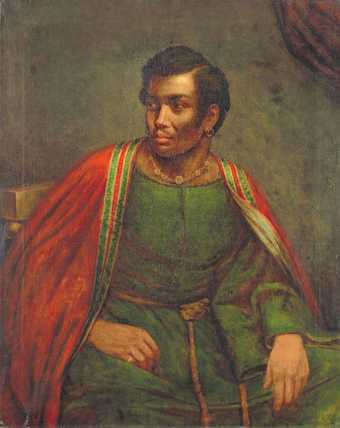
Henry Perronet Briggs Ira Aldridge as Othello 1830
Smithsonian National Portrait Gallery
In relation to The Captive Slave, Head of a Man now looks a little different. When exhibited in 2005, the artwork was titled Male Head Study [The Captive Slave], linking it directly to Simpson's other work. The costume Aldridge wears is similar to the one he wears in The Captive Slave. While in Head of a Man we might see it as some kind of costume of a stage actor, the costume could actually be the clothes of an enslaved person. Perhaps, the character Simpson was painting was a enslaved person and he was using Aldridge as a figurehead for his race. If done positively, it is possible Simpson did so to promote the emancipation of enslaved people. He was painting a face that had been somewhat relatively accepted by the public, despite being Black, and using it to possibly humanise enslaved people. In both works, Aldridge is not an individual. He is an everyman - a figure that symbolises the suffering of Black people on a large scale.
Victim or Hero?
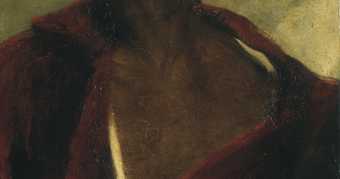
The way Simpson’s figure is portrayed in this painting provokes two very different readings of Aldridge. The perspective is from below, elevating him in some way. His gaze, directed into the distance, is custom for a philosophical stance. It is as if he is thinking of things that are beyond the minds of the average man. He is presented as a quintessential hero. Even the red robe, flowing behind him, feels aristocratic.
From another perspective, however, you could see him as a victim. Here is a Black man, dressed in what might be the clothes of a slave. Is Simpson inviting you to empathise with him? It is perhaps that his stare into the distance is more melancholy, an indication of his suffering.
Maybe Simpson’s purpose was to wed these two readings. Like the tragic heroes Aldridge played on stage, here he is both a victim of circumstance and a hero the audience can support. Aldridge could be the perfect casting to showcase the suffering of the Black individual to an unsympathetic viewer.
What do you think?
Framing the Man
Simpson painted the painting in an oval shape. The reason for this is unclear, but the framing of the piece suggests that this was to emphasise the heroic side of the painting. It feels like a halo that illuminates the features of the face, in the foreground of a stormy background. It evokes references to religious works, with Aldridge here being depicted as someone of significance. In its current form, it is framed in a perfect round. Its shape differentiates it from the rest of the artwork it is displayed next to. Perhaps unintentional, it is still noticeable that its shape is as different from the norm as the race of its subject.

The Creator
While Aldridge became an internationally recognised name, Simpson has not been as well appreciated. In a rare circumstance, the assumed subject of the painting has eclipsed the artist. Simpson was a gifted painter and regularly exhibited his portraiture at the Royal Academy. He was, however, an assistant to Sir Thomas Lawrence and helped him with many of the commissions he was working on. As a result, his own critical reputation suffered and he was unable to make a name for himself. His other portraits have never managed to achieve the same level of recognition as Head of a Man or The Captive Slave.

John Simpson Frederick Marryat 1826
National Portrait Gallery
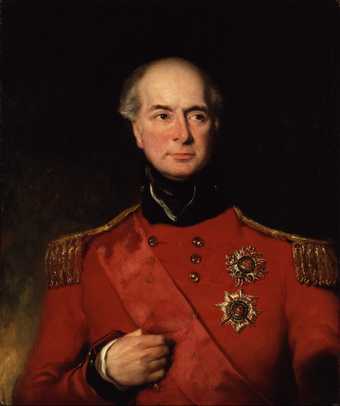
John Simpson Sir Herbert Taylor 1833
National Portrait Gallery
Looking at other portraits of Aldridge, they paint him as an actor, a free man and a man of some wealth. Head of a Man could be seen to do the same, but when compared to The Captive Slave this reading is called into question. It would not be too far a leap to say that Simpson used Head of a Man and The Captive Slave as a way to contribute a voice in regards to slavery. Perhaps, he thought the situation was topical given the context of the time or he was a genuine sympathiser of the cause. We do not have enough evidence to support either motive, but it is clear the politics of the day interested Simpson.
The Legacy
Head of a Man is a landmark artwork. As it sits in the walls of Tate Britain, it stands out for being one of the few works depicting a Black individual created in its time period by a British artist. While it possibly responds to the slave trade, today it can be interpreted to depict Blackness as heroic and admirable.
The painting has helped humanise Black people to a systemically racist society. Yet, at the same time, it has depersonalised its subject. The custom to not name Aldridge, because of his skin colour, makes this less of a portrait and more of a character study. Aldridge, if we can be sure it is him, has become a figure head for his race. How can we view the painting with modern eyes? Can we reclaim Aldridge’s identity as a way to understand the Black experience in the context of slavery and in the knowledge that Aldridge was a free man? Or is the apparent lack of identity important for Simpson's intentions for this artwork?
It does call into question though how much emphasis should be placed on Aldridge’s skin colour. Doing so risks placing him as a representative of all Black people. Not doing so, risks undermining the importance of skin colour in the context of this artwork. The politics of art never do end and debate surrounding this artwork will inevaitably continue. Posing these questions though is what makes the legacy of Simpson's work all the more interesting.
Have a Go

Some might say that Head of a Man is a form of protest. It might have changed opinions about slavery and the Black race. Can a painting today do the same? Create an equivalent painting that could be used as a protest for the Black Lives Matter movement or create your own response to the work.
- What does this look like?
- Would one figure be enough to articulate the complexity of the Black experience?
- How can you share your painting or response?
- Who are you creating it for?
or
Can you help Aldridge reclaim his identity? Use photo editing software to rework the painting to showcase Aldridge's identity. Here a few things to consider:
- What could you add to the painting to make an audience understand who this man was?
- What interests or hobbies did Aldridge have that you could highlight in this portrait? Perhaps, you could add a skull to show his interest in Shakespeare. Maybe, you could add a mask to show his interest in theatre.
- Could you paint another portrait of Aldridge as an actor?
- Most of the paintings of Aldridge show him playing Othello. What other characters could you show him playing?
